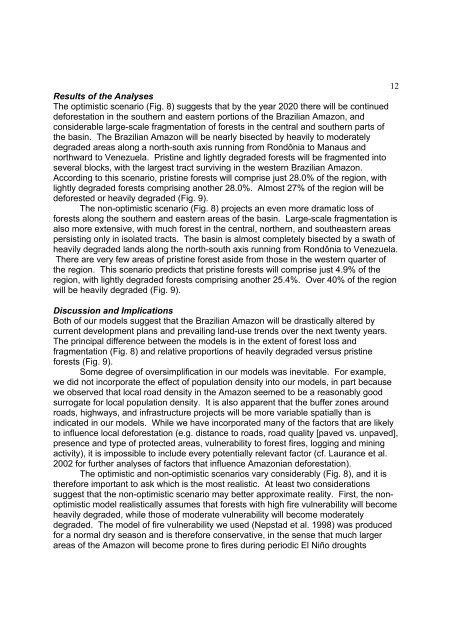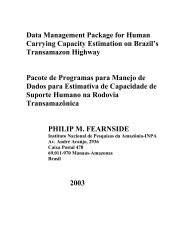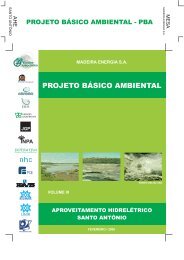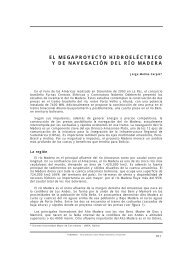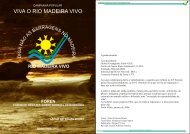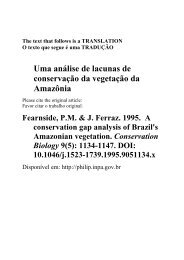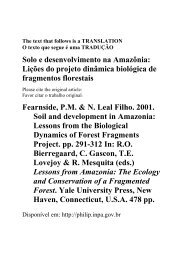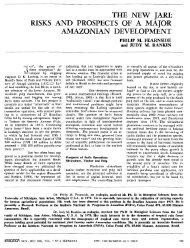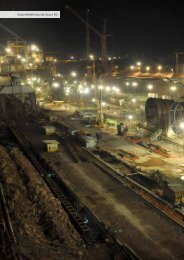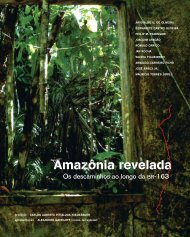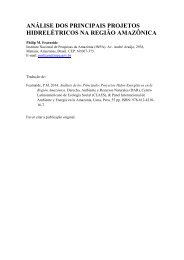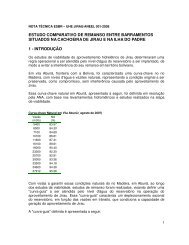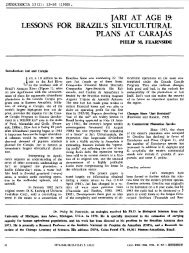THE FUTURE OF THE AMAZON - Philip M. Fearnside - Inpa
THE FUTURE OF THE AMAZON - Philip M. Fearnside - Inpa
THE FUTURE OF THE AMAZON - Philip M. Fearnside - Inpa
You also want an ePaper? Increase the reach of your titles
YUMPU automatically turns print PDFs into web optimized ePapers that Google loves.
12Results of the AnalysesThe optimistic scenario (Fig. 8) suggests that by the year 2020 there will be continueddeforestation in the southern and eastern portions of the Brazilian Amazon, andconsiderable large-scale fragmentation of forests in the central and southern parts ofthe basin. The Brazilian Amazon will be nearly bisected by heavily to moderatelydegraded areas along a north-south axis running from Rondônia to Manaus andnorthward to Venezuela. Pristine and lightly degraded forests will be fragmented intoseveral blocks, with the largest tract surviving in the western Brazilian Amazon.According to this scenario, pristine forests will comprise just 28.0% of the region, withlightly degraded forests comprising another 28.0%. Almost 27% of the region will bedeforested or heavily degraded (Fig. 9).The non-optimistic scenario (Fig. 8) projects an even more dramatic loss offorests along the southern and eastern areas of the basin. Large-scale fragmentation isalso more extensive, with much forest in the central, northern, and southeastern areaspersisting only in isolated tracts. The basin is almost completely bisected by a swath ofheavily degraded lands along the north-south axis running from Rondônia to Venezuela.There are very few areas of pristine forest aside from those in the western quarter ofthe region. This scenario predicts that pristine forests will comprise just 4.9% of theregion, with lightly degraded forests comprising another 25.4%. Over 40% of the regionwill be heavily degraded (Fig. 9).Discussion and ImplicationsBoth of our models suggest that the Brazilian Amazon will be drastically altered bycurrent development plans and prevailing land-use trends over the next twenty years.The principal difference between the models is in the extent of forest loss andfragmentation (Fig. 8) and relative proportions of heavily degraded versus pristineforests (Fig. 9).Some degree of oversimplification in our models was inevitable. For example,we did not incorporate the effect of population density into our models, in part becausewe observed that local road density in the Amazon seemed to be a reasonably goodsurrogate for local population density. It is also apparent that the buffer zones aroundroads, highways, and infrastructure projects will be more variable spatially than isindicated in our models. While we have incorporated many of the factors that are likelyto influence local deforestation (e.g. distance to roads, road quality [paved vs. unpaved],presence and type of protected areas, vulnerability to forest fires, logging and miningactivity), it is impossible to include every potentially relevant factor (cf. Laurance et al.2002 for further analyses of factors that influence Amazonian deforestation).The optimistic and non-optimistic scenarios vary considerably (Fig. 8), and it istherefore important to ask which is the most realistic. At least two considerationssuggest that the non-optimistic scenario may better approximate reality. First, the nonoptimisticmodel realistically assumes that forests with high fire vulnerability will becomeheavily degraded, while those of moderate vulnerability will become moderatelydegraded. The model of fire vulnerability we used (Nepstad et al. 1998) was producedfor a normal dry season and is therefore conservative, in the sense that much largerareas of the Amazon will become prone to fires during periodic El Niño droughts


